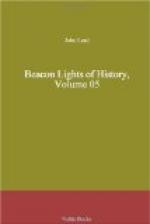The Crusades, as they were historically developed, are mixed up with the religious ideas of the Middle Ages, with the domination of popes, with the feudal system, with chivalry, with monastic life, with the central power of kings, with the birth of mercantile States, with the fears and interests of England, France, Germany, and Italy, for two hundred years,—yea, with the architecture, commerce, geographical science, and all the arts then known. All these principalities and powers and institutions and enterprises were affected by them, so that at their termination a new era in civilization began. Grasp the Crusades, and you comprehend one of the forces which undermined the institutions of the Middle Ages.
It is not a little remarkable that the earliest cause of the Crusades, so far as I am able to trace, was the adoption by the European nations of some of the principles of Eastern theogonies which pertained to self-expiation. An Asiatic theological idea prepared the way for the war between Europe and Asia. The European pietist embraced the religious tenets of the Asiatic monk, which centred in the propitiation of the Deity by works of penance. One of the approved and popular forms of penance was a pilgrimage to sacred places,—seen equally among degenerate Christian sects in Asia Minor, and among the Mohammedans of Arabia. What place so sacred as Jerusalem, the scene of the passion and resurrection of our Lord? Ever since the Empress Helena had built a church at Jerusalem, it had been thronged with pious pilgrims. A pilgrimage to old Jerusalem would open the doors of the New Jerusalem, whose streets were of gold, and whose palaces were of pearls.
At the close of the tenth century there was great suffering in Europe, bordering on despair. The calamities of ordinary life were so great that the end of the world seemed to be at hand. Universal fear of impending divine wrath seized the minds of men. A great religious awakening took place, especially in England, France, and Germany. In accordance with the sentiments of the age, there was every form of penance to avert the anger of God and escape the flames of hell. The most popular form of penance was the pilgrimage to Jerusalem, long and painful as it was. Could the pilgrim but reach that consecrated spot, he was willing to die. The village pastor delivered the staff into his hands, girded him with a scarf, and attached to it a leathern scrip. Friends and neighbors accompanied him a little way on his toilsome journey, which lay across the Alps, through the plains of Lombardy, over Illyria and Pannonia, along the banks of the Danube, by Moesia and Dacia, to Belgrade and Constantinople, and then across the Bosphorus, through Bithynia, Cilicia, and Syria, until the towers and walls of Tyre, Ptolemais, and Caesarea proclaimed that he was at length in the Holy Land. Barons and common people swell the number of these pilgrims. The haughty knight, who has committed unpunished murders, and the pensive




